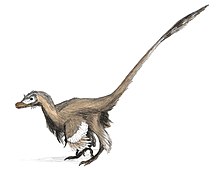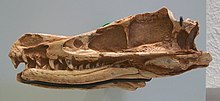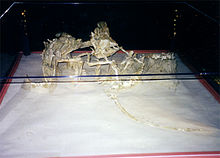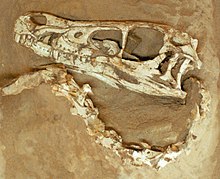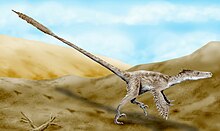Velociraptor
| Velociraptor | ||||||||||||
|---|---|---|---|---|---|---|---|---|---|---|---|---|
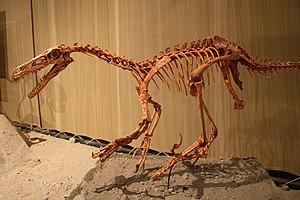
Skeletal reconstruction of Velociraptor |
||||||||||||
| Temporal occurrence | ||||||||||||
| Upper Cretaceous (late Santonium to Middle Campanium ) | ||||||||||||
| 85.2 to 76.4 million years | ||||||||||||
| Locations | ||||||||||||
| Systematics | ||||||||||||
|
||||||||||||
| Scientific name | ||||||||||||
| Velociraptor | ||||||||||||
| Osborn , 1924 | ||||||||||||
| species | ||||||||||||
|
||||||||||||
Velociraptor ( lat. Velox 'fast', raptor 'predator') is a genus of theropod dinosaur from the group of Dromaeosauridae , which lived about 85 to 76 million years ago in the late Cretaceous period .
Two species are currently recognized: the type Velociraptor mongoliensis , the fossil bones of which were found in Mongolia and Inner Mongolia (China), and the species Velociraptor osmolskae, described in 2008 and previously only known from skull material from Inner Mongolia . With over a dozen fossil skeletons discovered, Velociraptor is one of the best-studied dromaeosaurids. A particularly popular fossil shows Velociraptor with a Protoceratops ; both animals apparently died during a fight.
With a length of up to two meters, Velociraptor was a medium-sized representative of the Dromaeosauridae. It was a feathered carnivore walking on two legs with a long, stiff tail and a conspicuously enlarged, sickle-like claw on the second toe of the rear foot. This "sickle claw" was probably used during hunting. A distinguishing feature to other dromaeosaurids is the long, flat and slightly curved snout.
Velociraptor is known to the general public in particular because of its artistic freedom as an intelligent man-eating predator in the Jurassic Park film series.
features
Velociraptor was a medium-sized dromaeosaurid with a length of up to 2.07 meters, a hip height of 50 centimeters and an estimated weight of up to 15 kilograms. The skull was up to 25 centimeters long and had a thin, flat and long snout compared to other dromaeosaurids: the snout made up 60% of the total length of the skull, but when viewed from above it showed only a third of the width of the rear skull. The front portion of the snout was curved slightly upward, resulting in a concave top and a convex bottom. The eyes were directed forward, which enabled good spatial vision . His spatial field of view was about 55 ° wide and 10 ° high; these are values comparable to owls . Each side of the jaw was covered with 26 to 28 teeth at larger distances, which were sawn more strongly on the rear cutting edge than on the front - this can be interpreted as an adaptation to the grasping of fast prey.
The skeleton of the hand was similar in structure and flexibility to that of birds and showed three strongly curved claws. The second finger was the longest finger, the first finger the shortest. Due to the structure of the carpal bones , pronation (inward rotation) of the wrist was impossible. This forced Velociraptor to always keep his hands palm-side inward. Like other dromaeosaurids, Velociraptor only ran on the third and fourth toes. As with other theropods , the first toe was reduced (" wolf's claw ") and did not touch the ground. The heavily modified second toe was also held above the ground: It had a conspicuously large, sickle-shaped claw up to 6.5 centimeters long, a typical feature of the Dromaeosauridae. It was probably used as a weapon in hunting. Recent biomechanical studies show that it was also suitable for climbing.
Extremely elongated bony processes connecting the vertebrae ( prezygapophyses ) to the vertebral arches, elongated chevron bones on the underside of the vertebrae and ossified tendons stiffened the tail of the Velociraptor . The prezygapophyses were formed from the tenth caudal vertebra and extended forward in rod-like bundles, depending on their position, jumping four to ten vertebrae. This stiffening severely restricted vertical movements of the tail, although a finding with an "S" -shaped tail with intact prezygapophyses suggests that the tail had considerable horizontal mobility. The tail adjustments were believed to have been beneficial in maintaining balance and stability when cornering at high speed. A biomechanical study calculated a maximum speed of 38.9 kilometers per hour.
In 2007, approaches for quills were found on a well-preserved forearm bone of Velociraptor , which confirms fletching in Velociraptor .
history

An expedition of the American Museum of Natural History (AMNH) into the Mongolian Gobi desert discovered the first known velociraptor fossil in 1922 : a crushed but complete skull together with one of the enlarged claws of the second toe and fragments of the foot bones (copy number AMNH 6515). 1924 took place first description by the museum director Henry Fairfield Osborn as Velociraptor mongoliensis . The generic name Velociraptor means something like "fast predator" (Latin: velox - "fast", raptor - "predator"), while the specific epithet mongoliensis refers to the country Mongolia, where the fossils were found. Earlier in the same year, Osborn named the new species in a press article "Ovoraptor djadochtari" (not to be confused with Oviraptor ); However, since this name was neither published in a scientific magazine nor through a formal description, it is considered a noun nudum ("naked name") according to the International Rules for Zoological Nomenclature (ICZN ), which is why the name Velociraptor enjoys priority.
While North American researchers were not allowed to enter Communist Mongolia during the Cold War , Soviet, Polish, and Mongolian researchers discovered other skeletons. In 1971 the famous fossil of the "fighting dinosaurs" was discovered by a Polish-Mongolian research group (specimen number GIN 100/25), which shows a Velociraptor during a fight with a Protoceratops . It is considered the national treasure of Mongolia but was loaned to the American Museum of Natural History in New York for a temporary exhibition in 2000. Today it is in the National Museum of Natural History in Ulaanbaatar .
Between 1988 and 1990 a Sino-Canadian team discovered remains of Velociraptor in northern China. American scientists returned to Mongolia in 1990, and a Mongolian-American team discovered several well-preserved skeletons.
In 1999, a Sino-Belgian team discovered an upper jaw and a tear bone that belonged to Velociraptor , but are atypical of the Velociraptor mongoliensis type . Researchers working with Pascal Godefroit described this find in 2008 as the holotype of a new species, Velociraptor osmolskae . It differs from Velociraptor mongoliensis mainly by an enlarged promaxillary window , a skull opening ( skull window ) in the upper jaw, which is located in the middle about the same height between the eye socket and the nostril. The species epithet osmolskae honors the Polish paleontologist Halszka Osmólska , who died shortly before the first description.
Locations
Most of the fossils of Velociraptor mongoliensis were found in the Djadochta Formation , both in Aimag Ömnö-Gobi, Mongolia, and Inner Mongolia, China . Velociraptor finds that have not yet been assigned to one of the two species also come from the somewhat younger Barun-Goyot Formation in Mongolia. These geological formations are dated to the Upper Cretaceous (late Santonian to Middle Campanian ) and are therefore around 85 to 76 million years old.
Velociraptor finds come from many of the famous and richest sites of the Djadochta Formation: The type specimen comes from Bajandsag or "Flaming Cliffs" (also known as Shabarakh Usu), while the "Fighting Dinosaurs" in the Turig site (Tugrugeen Shireh) were discovered. Known sites of the Barun Goyot Formation, Khulsan and Khermeen Tsav, also contained fossils that may have belonged to Velociraptor . Teeth and fragmentary bone fragments attributed to juvenile Velociraptor mongoliensis come from the Bayan Mahandu Formation in Inner Mongolia. The skull material of Velociraptor osmolskae was also found there.
Paleoecology
All sedimentary rock layers with Velociraptor fossils show evidence of a dry climate at the time of the deposition. The landscape was characterized by seasonally drying waters and sand dunes, and the climate was similar to that of today's humid tropics . During the deposition of the younger Barun-Goyot Formation, the climate was slightly more humid than at the time of the deposition of the Djadochta Formation. The posture of some complete skeletons and their preservation in structureless sandstone deposits suggests that these specimens were buried alive in the course of the frequent sandstorms. Velociraptor lived together with ceratopsians such as Protoceratops , Udanoceratops , ankylosaurids such as Pinacosaurus and various theropods such as oviraptorids , troodontids , Alvarezsauriden and other dromaeosaurids such as Adasaurus . Many types of dinosaurs occur in the Djadochta Formation and the Barun-Goyot Formation as well as in the Bayan-Mandahu Formation, whereby the representatives from different formations are often assigned to different species. For example, the Djadochta fauna consisted of Velociraptor mongoliensis , Protoceratops andrewsi , and Pinacosaurus grangeri , while the Bayan Mandahu fauna included Velociraptor osmolskae , Protoceratops hellenikorhinus, and Pinacosaurus mephistocephalus . These differences in species composition could be due to a natural barrier separating the two geographically closely spaced formations or to a slight difference in their stratigraphic age.
Systematics
Velociraptor belongs to the subfamily Velociraptorinae, an advanced (derived) subgroup of the Dromaeosauridae family . In the phylogenetic systematics (cladistics), the Velociraptorinae are usually defined as "all dromaeosaurids that are more closely related to Velociraptor than to Dromaeosaurus ". While Velociraptor was initially classified as the only genus within the Velociraptorinae, some later analyzes added other genera - mostly Deinonychus and Saurornitholestes . The relationships within the Dromaeosauridae, however, remain controversial. A current cladistic analysis by researchers around Mark Norell (2006) outlines a genus Velociraptorinae, which includes Velociraptor , Deinonychus , Tsaagan and Saurornitholestes . Another analysis by Longrich and Currie (2009) assigns the genera Velociraptor , Itemirus , Tsaagan and Adasaurus to the Velociraptorinae , with Itemirus being considered to be the genus most closely related to Velociraptor . Csiki and colleagues (2010) conclude that the recently discovered Balaur was Velociraptor's closest relative .
A current classification example follows (simplified according to Longrich and Currie, 2009):
| Dromaeosauridae |
|
|||||||||||||||||||||||||||||||||||||||||||||||||||||||||||||||||||||
|
|
In the past, some researchers suggested that some other dromaeosaurids, such as Deinonychus antirrhopus and Saurornitholestes langstoni, were species of Velociraptor . Accordingly, the species would Deinonychus and saurornitholestes with Velociraptor been identical - but since Velociraptor is the first assigned name, it retains priority. So these species were renamed Velociraptor antirrhopus and Velociraptor langstoni . Today only Velociraptor mongoliensis and Velociraptor osmolskae are recognized species of Velociraptor .
When it was first described in 1924, Velociraptor was placed in the Megalosauridae family , to which almost all known carnivorous dinosaurs were then assigned. The Megalosauridae and in particular Megalosaurus were used for a long time as so-called "trash can taxa ", to which a large number of finds of apparently not closely related theropods were attributed ( polyphyletic ). In the period that followed, various authors attributed Velociraptor to the Compsognathidae and the Coeluridae, among others . Velociraptor has only been classified within the Dromaeosauridae family together with Dromaeosaurus and Deinonychus since 1969 .
The Dromaeosauridae form together with the Troodontidae the group Deinonychosauria , which in turn is counted to the Maniraptora . The Deinonychosauria are often considered to be a sister group of birds. Some researchers even suspect that the Dromaeosauridae includes the birds as a subgroup, that is, that birds are descended from primitive members of the Dromaeosauridae that cannot yet be assigned to birds ("non-bird dromaeosaurids"). Various researchers suspect that the dromaeosaurids, including the velociraptor, were actually a group within the birds that was secondarily unable to fly.
Paleobiology
Hunting behavior
The characteristic sickle claw of the second toe of the dromaeosaurids was often interpreted in the past as a device for slitting large prey. Manning and colleagues (2005) carried out experiments with a hydraulic robotic model of the Deinonychus foot on the abdominal wall of a pig and showed that the sickle claw of the dromaeosaurids only left small and round puncture holes, but was not able to slit open the abdominal wall. These researchers suspect that the sickle claw may have acted as a type of crampon that the dromaeosaurids could use to hold on to large prey, while hands and teeth caused numerous injuries to the prey.
The fossil of the "fighting dinosaurs" gives direct clues to the hunting behavior of Velociraptor , which shows a Velociraptor mongoliensis in the middle of a fight with a Protoceratops andrewsi : Velociraptor's left hand lies directly behind the cheek horn of Protoceratops , while the latter shows the right forearm of Velociraptor holding on with his beak. The Velociraptor's right foot appears to be trapped under the Protoceratops' body . The left foot is stretched out into the neck region of the Protoceratops with the sickle claw pointing downwards . Carpenter (1998) suggests that the sickle claw was not used to slit, but to puncture the windpipe or the neck veins.
The sedimentary structures in which the two skeletons are preserved were originally interpreted as deposits of a river delta , from which Barsbold (1974) concluded that the animals drowned. However, later investigations showed that they were Aeolian (wind-created) deposits of sand dunes . The animals may have suddenly been buried alive by sand during the fight - either from a collapsing dune or from a sandstorm. Carpenter (1998) notes, however, that both the front and rear legs of the Protoceratops specimen are missing, which contradicts the hypothesis of a live burial. To explain this finding, he suggests another scenario: The velociraptor could have killed the Protoceratops , with its right leg trapped under the carcass of the Protoceratops , so that the Velociraptor could no longer free itself and died. Scavengers may have carried the Protoceratops' legs away before both carcasses were covered in drifting sand .
The related dromaeosaurid Deinonychus may have lived and hunted in groups. Corresponding evidence comes from two quarries, each of which housed the remains of several Deinonychus along with the remains of the large herbivore Tenontosaurus . The only indubitable evidence of group life in dromaeosaurids are six fossilized footprints of a larger dromaeosaurid species from China that run side by side; However, this find does not provide any evidence of hunting in groups. Although many isolated Velociraptor finds are known, no individual has been found in association with any other individual. Thus, there is limited evidence of group life in dromaeosaurids and no single evidence specific to velociraptor , although velociraptor is regularly portrayed as living and hunting in groups in popular media such as the Jurassic Park film .
Necrophagy
In 2008, paleontologists in the Bayan Mahandu Formation found teeth, believed to be Velociraptor , around a bite-tracked jawbone, believed to be from Protoceratops . This find is interpreted as evidence for the consumption of carrion ( necrophagy ) by Velociraptor , as this would first have eaten other parts of the body of a freshly killed Protoceratops . It was also confirmed that Protoceratops was one of Velociraptor's prey .
metabolism
Velociraptor was probably warm-blooded ( endothermic ) to a certain extent , but the growth rate of the bones of dromaeosaurids indicates a lower metabolism compared to mammals and birds . The construction of the respiratory system and the fact that an ectothermic metabolism was probably not able to support the rapid, bipedous locomotion of a Velociraptor over a longer period of time give further indications of endothermia .
feathers
Fossils of original dromaeosaurids show extensive fletching and fully developed wings, which prompted paleontologists to investigate whether Velociraptor could also have been feathered. In 2007, at an Elle of Velociraptor proven approaches for twelve quills of secondaries, whereby a fletching was finally confirmed.
The feathers may have played a role in some form of expressive behavior, for example before mating, or they may have helped the eggs to hatch as in today's birds. Stabilizing walking at high speed could also have been beneficial and encouraged the evolution of plumage.
Velociraptor in popular culture
Velociraptor was known for his role as a cruel hunters in the novel Jurassic Park by Michael Crichton and the film Jurassic Park by the director Steven Spielberg . The "raptors" take on the roles of the main antagonists who chase the human protagonists through a dinosaur zoo. They were originally based on Deinonychus , a larger relative of Velociraptor , who was then called Velociraptor antirrhopus by the paleontologist Gregory S. Paul . A character in Michael Crichton's novel also says that "... Deinonychus belongs to the Velociraptors". This shows that Crichton used Gregory Paul's classification, even though they are consistently referred to as Velociraptor mongoliensis .
For dramaturgical reasons, the "raptors" in the film have been significantly enlarged and the shape of the snout changed. The construction and position of the arms were also changed, and the tails were made very short and flexible, which clearly contradicts the anatomy of the fossils. The lack of fletching in the novel and film is also noticeable. However, the fact that Velociraptor was feathered was unknown during the production of Jurassic Park and Forgotten World: Jurassic Park . In Jurassic Park III , the "raptors" were shown with feathers on their heads and necks, which do not correspond to the actual fletching of dromaeosaurids. In a scene in Jurassic Park 3, it is also mentioned that the intelligence of the "raptors" exceeds that of dolphins , whales and some primates . However, this is highly unlikely due to the volume of the brain.
The success of Jurassic Park made Velociraptor one of the most recognizable dinosaurs in popular culture. It appears in many toy lines, video games, television series, films, and documentaries. In 2011 the British indie rock band Kasabian released an album entitled Velociraptor , on which guitarist Sergio Pizzorno is shown in an aggressive pose with feathers, as they are ascribed to the dinosaur. There is a track of the same name on the album.
Velociraptor also serves as a name model for the professional basketball team in Toronto, the Toronto Raptors , founded in 1995 . In addition, the mascot that originally graced the team logo is obviously based on Velociraptor .
In the 1997 cartoon series Extreme Dinosaurs , the three main antagonists are velociraptors. You and the other dinosaurs in the series are humanoid or anthropomorphic , e.g. B. are all about the same size and only slightly taller than humans, wear clothes and use futuristic tools and means of transport.
The first feathered model of a Velociraptor is in the exhibition Dinosaurs - Primeval times are alive! to be seen in the LWL-Museum für Naturkunde in Münster .
Web links
Individual evidence
- ^ Gregory S. Paul : The Princeton Field Guide To Dinosaurs. Princeton University Press, Princeton NJ et al. 2010, ISBN 978-0-691-13720-9 , p. 137, online .
- ↑ a b c d e Henry Fairfield Osborn : Three new Theropoda, Protoceratops zone, central Mongolia (= American Museum Novitates. Nr. 144, ISSN 0003-0082 = Publications of the Asiatic Expeditions of the American Museum of Natural History. Contribution. Nr . 32). The American Museum of Natural History, New York NY 1924, online .
- ↑ a b c d e f g Pascal Godefroit, Philip J. Currie , Li Hong, Shang Chang Yong, Dong Zhi-Ming: A new species of Velociraptor (Dinosauria: Dromaeosauridae) from the Upper Cretaceous of northern China. Vol. 28, No. 2, 2008, ISSN 0272-4634 , pp. 432-438, doi : 10.1671 / 0272-4634 (2008) 28 [432: ANSOVD] 2.0.CO; 2 .
- ^ A b c Gregory S. Paul: Predatory Dinosaurs of the World. A complete and illustrated guide. Simon and Schuster, New York NY et al. 1988, ISBN 0-671-61946-2 , p. 464 ff.
- ↑ Kent A. Stevens: Binocular vision in theropod dinosaurs. In: Journal of Vertebrate Paleontology. Vol. 26, No. 2, 2006, pp. 321-330, doi : 10.1671 / 0272-4634 (2006) 26 [321: BVITD] 2.0.CO; 2 .
- ^ A b Rinchen Barsbold , Halszka Osmólska : The skull of Velociraptor (Theropoda) from the Late Cretaceous of Mongolia. In: Acta Palaeontologica Polonica. Vol. 44, No. 2, 1999, ISSN 0567-7920 , pp. 189-219, online .
- ^ A b c d Gregory S. Paul: Dinosaurs of the Air. The Evolution and Loss of Flight in Dinosaurs and Birds. Johns Hopkins University Press, Baltimore MD et al. 2002, ISBN 978-0-8018-6763-7 .
- ↑ a b c d Ринченгийн Барсболд: Хищные динозавры мела Монголии. Совместная Советско-Монгольская палеонтологическая экспедиция (= Труды. 19). Наука, Москва 1983, pp. 5–119 (In English: Rinchen Barsbold: Carnivorous dinosaurs from the Cretaceous of Mongolia. The Joint Soviet-Mongolian Paleontological Expedition (= Transaction of the Joint Soviet-Mongolian Paleontological Expedition. Vol. 19). Self-published by the author, Berkeley CA 1983, 5-119, online ).
- ↑ a b c Mark A. Norell , Peter J. Makovicky : Important features of the dromaeosaurid skeleton II: information from newly collected specimens of Velociraptor mongoliensis (= American Museum Novitates. No. 3282). The American Museum of Natural History, New York NY 1999, online .
- ↑ Phillip L. Manning, Lee Margetts, Mark R. Johnson, Philip J. Withers, William I. Sellers, Peter L. Falkingham, Paul M. Mummery, Paul M. Barrett , David R. Raymont: Biomechanics of Dromaeosaurid Dinosaur Claws: Application of X-Ray Microtomography, Nanoindentation, and Finite Element Analysis. In: The Anatomical Record . Vol. 292, No. 9, 2009, ISSN 1932-8486 , pp. 1397-1405, doi : 10.1002 / ar.20986 .
- ^ William Irvin Sellers, Phillip Lars Manning: Estimating dinosaur maximum running speeds using evolutionary robotics. In: Proceedings of the Royal Society. Series B: Biological Sciences. Vol. 274, No. 1626, 2007, ISSN 0950-1193 , pp. 2711-2716, doi : 10.1098 / rspb.2007.0846 .
- ↑ a b c d Alan H. Turner, Peter J. Makovicky, Mark A. Norell: Feather Quill Knobs in the Dinosaur Velociraptor. Vol. 317, No. 5845, 2007, p. 1721, doi : 10.1126 / science.1145076 , PMID 17885130 .
- ^ Henry Fairfield Osborn: The Discovery of an Unknown Continent. In: Natural History. Vol. 24, No. 2, 1924, ISSN 0028-0712 , pp. 133-149, digitized .
- ^ Zofia Kielan-Jaworowska , Rinchen Barsbold: Narrative of the Polish-Mongolian Paleontological Expeditions. In: Palaeontologia Polonica. Vol. 27, 1972, ISSN 0078-8562 , pp. 5-13.
- ↑ a b c Rinchen Barsbold: Saurornithoididae, a new family of theropod dinosaurs from Central Asia and North America. In: Palaeontologia Polonica. Vol. 30, 1974, ISSN 0078-8562 , pp. 5-22.
- ^ American Museum of Natural History: Fighting Dinosaurs: New Discoveries from Mongolia: Exhibition Highlights . c.2000. Retrieved August 1, 2014.
- ↑ Ch.Sumiyabazar: Mongolia's fighting dinosaurs in the UB-Post (English-language, Mongolian magazine) of February 14, 2006
- ↑ Photo of the Fighting Dinosaurs from the National Museum of National History
- ↑ a b Tomasz Jerzykiewicz, Philip J. Currie, David A. Eberth, Paul A. Johnston, Emlyn H. Koster, Jia-Jian Zheng: Djadokhta Formation correlative strata in Chinese Inner Mongolia: an overview of the stratigraphy, sedimentary geology, and paleontology and comparisons with the type of locality in the pre-Altai Gobi. In: Canadian Journal of Earth Sciences. Vol. 30, No. 10, 1993, ISSN 0008-4077 , pp. 2180-2195. doi : 10.1139 / e93-190 .
- ^ Mark A. Norell, Peter J. Makovicky: Important features of the dromaeosaur skeleton: information from a new specimen (= American Museum Novitates. No. 3215). The American Museum of Natural History, New York NY 1997, online .
- ^ Obituary of the Society of Vertebrate Palaeontology ( Memento of October 27, 2010 in the Internet Archive )
- ^ A b David B. Weishampel , Paul M. Barrett, Rodolfo A. Coria , Jean Le Loueff, Xing Xu , Xijin Zhao , Ashok Sahni, Emily MP Gomani, Christopher N. Noto: Dinosaur distribution. In: David B. Weishampel, Peter Dodson , Halszka Osmólska (eds.): The Dinosauria . 2nd edition. University of California Press, Berkeley CA et al. 2004, ISBN 0-520-24209-2 , pp. 517-606.
- ↑ Felix M. Gradstein, James G. Ogg, Alan G. Smith (Eds.): A Geologic Time Scale 2004. Cambridge University Press, Cambridge 2005, ISBN 0-521-78142-6 .
- ↑ a b Tomasz Jerzykiewicz, Dale A. Russell : Late Mesozoic stratigraphy and vertebrates of the Gobi Basin. In: Cretaceous Research. Vol. 12, No. 4, 1991, ISSN 0195-6671 , pp. 345-377, doi : 10.1016 / 0195-6671 (91) 90015-5 .
- ↑ Halszka Osmólska: Barun Goyot Formation. In: Philip J. Currie, Kevin Padian (Eds.): Encyclopedia of Dinosaurs. Academic Press, San Diego CA et al. 1997, ISBN 0-12-226810-5 , p. 41.
- ^ Philip J. Currie: New information on the anatomy and relationships of Dromaeosaurus albertensis (Dinosauria: Theropoda). In: Journal of Vertebrate Paleontology. Vol. 15, No. 3, 1995, pp. 576-591, doi : 10.1080 / 02724634.1995.10011250 .
- ↑ James M. Clark, Alan H. Turner, Peter J. Makovicky, Rinchen Barsbold, Timothy Rowe: A new dromaeosaurid theropod from Ukhaa Tolgod (Omnogov, Mongolia) (= American Museum Novitates. No. 3545). The American Museum of Natural History, New York NY 2006, online .
- ^ A b Nicolas R. Longrich, Philip J. Currie: A microraptorine (Dinosauria - Dromaeosauridae) from the late Cretaecous of North Aermica. In: Proceedings of the National Academy of Sciences . Vol. 106, No. 13, 2009, pp. 5002-5007, doi : 10.1073 / pnas.0811664106 .
- ^ Zoltán Csiki, Mátyás Vremir, Stephen L. Brusatte, Mark A. Norell: An aberrant island-dwelling theropod dinosaur from the Late Cretaceous of Romania. In: Proceedings of the National Academy of Sciences . Vol. 107, No. 35, 2010, pp. 15357-15361, doi : 10.1073 / pnas.1006970107 .
- ↑ a b Mark A. Norell, Peter J. Makovicky: Dromaeosauridae. In: David B. Weishampel, Peter Dodson, Halszka Osmólska (eds.): The Dinosauria . 2nd edition. University of California Press, Berkeley CA et al. 2004, ISBN 0-520-24209-2 , pp. 196-209.
- ↑ Velociraptor . In: The Paleobiology Database . Retrieved August 1, 2014 .
- ^ Edwin H. Colbert , Dale A. Russell: The small Cretaceous dinosaur Dromaeosaurus (= American Museum Novitates. No. 2380). The American Museum of Natural History, New York NY 1969, digitized .
- ↑ Sunny H. Hwang, Mark A. Norell, Ji Qiang, Gao Keqin: New specimens of Microraptor zhaoianus (Theropoda, Dromaeosauridae) from northeastern China. American Museum Novitates (= American Museum Novitates. No. 3381). The American Museum of Natural History, New York NY 2002, digitized .
- ^ Alan H. Turner, Diego Pol, Julia A. Clarke, Gregory M. Erickson, Mark A. Norell: A Basal Dromaeosaurid and Size Evolution Preceding Avian Flight. In: Science. Vol. 317, No. 5843, 2007, pp. 1378-1381, doi : 10.1126 / science.1144066 .
- ↑ Mark A. Norell, James M. Clark, Peter J. Makovicky: Phylogenetic relationships among coelurosaurian theropods. In: Jacques Gauthier , Lawrence F. Gall (Eds.): New Perspectives on the Origin and early Evolution of Birds. Proceedings of the International Symposium in Honor of John H. Ostrom. February 13-14, 1999. New Haven, Connecticut. Peabody Museum of Natural History - Yale University, New Haven CT 2001, ISBN 0-912532-57-2 , pp. 49-67, online (PDF; 72.38 KB) .
- ^ Larry D. Martin : A basal archosaurian origin for birds. In: Acta Zoologica Sinica. Vol. 50, No. 6, 2004, ISSN 0001-7302 , pp. 978-990.
- ^ John H. Ostrom : Osteology of Deinonychus antirrhopus, an unusual theropod from the Lower Cretaceous of Montana (= Bulletin of the Peabody Museum of Natural History. Vol. 30, ISSN 0079-032X ). Peabody Museum of Natural History - Yale University, New Haven CI 1969.
- ^ Phillip L. Manning, David Payne, John Pennicott, Paul M. Barrett, Roland A. Ennos: Dinosaur killer claws or climbing crampons? In: Biology Letters. Vol. 2, No. 1, 2005, ISSN 1744-9561 , pp. 110-112, doi : 10.1098 / rsbl.2005.0395 .
- ↑ a b Ken Carpenter : Evidence of predatory behavior by theropod dinosaurs. In: Gaia. Revista de Geociências. Vol. 15, 1998, ISSN 0871-5424 , pp. 135-144.
- ^ W. Desmond Maxwell, John H. Ostrom: Taphonomy and paleobiological implications of Tenontosaurus-Deinonychus associations. In: Journal of Vertebrate Paleontology. Vol. 15, No. 4, 1995, pp. 707-712, doi : 10.1080 / 02724634.1995.10011256 .
- ^ Daniel L. Brinkman, Richard L. Cifelli, Nicholas J. Czaplewski: First occurrence of Deinonychus antirrhopus (Dinosauria: Theropoda) from the Antlers Formation (Lower Cretaceous: Aptian-Albian) of Oklahoma (= Oklahoma Geological Survey Bulletin. Vol. 146 , ISSN 0078-4389 ). University of Oklahoma, Norman OK 1998, digitized version (PDF; 2.13 MB) .
- ↑ Rihui Li, Martin G. Lockley, Peter J. Makovicky, Masaki Matsukawa, Mark A. Norell, Jerald D. Harris, Mingwei Liu: Behavioral and faunal implications of Early Cretaceous deinonychosaur trackways from China. In: The natural sciences . Vol. 95, No. 3, 2008, pp. 185-191, doi : 10.1007 / s00114-007-0310-7 , PMID 17952398 .
- ↑ a b c David Hone, Jonah Choiniere, Corwin Sullivan, Xing Xu, Michael Pittman, Qingwei Tan: New evidence for a trophic relationship between the dinosaurs Velociraptor and Protoceratops. In: Palaeogeography, Palaeoclimatology, Palaeoecology. Vol. 291, No. 3/4, 2010, ISSN 0031-0182 , pp. 488-492, doi : 10.1016 / j.palaeo.2010.03.028 .
- ^ Matt Walker: Fossil find shows Velociraptor eating another dinosaur . In: BBC Earth News , April 6, 2010. Retrieved August 1, 2014.
- ↑ Herman Pontzer, Vivian Allen, John R. Hutchinson: Biomechanics of Running Indicates Endothermy in Bipedal Dinosaurs. In: PLOS ONE . Vol. 4, No. 11, 2009, e7783, doi : 10.1371 / journal.pone.0007783 , (on this: Corrections. In: PLoS One. Vol. 4, No. 12, 2009, doi : 10.1371 / annotation / 635e46fc- 4be3-4f42-ad5c-ee3a276cd24f ).
- ↑ Xing Xu, Zhonghe Zhou , Xiaolin Wang, Xuewen Kuang, Fucheng Zhang, Xiangke Du: Four-winged dinosaurs from China. In: Nature . Vol. 421, No. 6921, 2003, pp. 335-340, doi : 10.1038 / nature01342 , PMID 12540892 .
- ↑ Michael Crichton : Jurassic Park. A novel. Alfred A. Knopf, New York, NY 1990, ISBN 0-394-58816-9 , p. 117.
- ↑ Jody Duncan: The Winston Effect. The Art and History of Stan Winston Studio. Titan Books, London 2006, ISBN 1-84576-365-3 , p. 175.
- ^ Robert T. Bakker : Raptor Red. Bantam Books, New York NY 1995, ISBN 0-553-57561-9 , p. 4.
- ^ Hans CE Larsson, Paul C. Sereno , Jeffrey A. Wilson: Forebrain enlargement among nonavian theropod dinosaurs. In: Journal of Vertebrate Paleontology. Vol. 20, No. 3, 2000, pp. 615-618, doi : 10.1671 / 0272-4634 (2000) 020 [0615: FEANTD] 2.0.CO; 2 .
- ^ Kasabian - The official site for news about the band Kasabian ( Memento of March 8, 2012 in the Internet Archive ).
- ↑ First feathered Velociraptor model in Germany .

